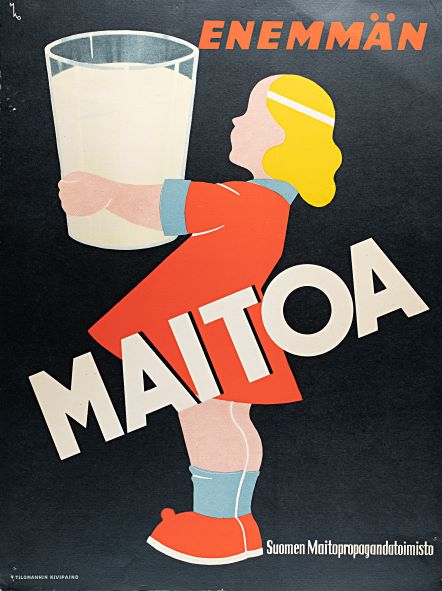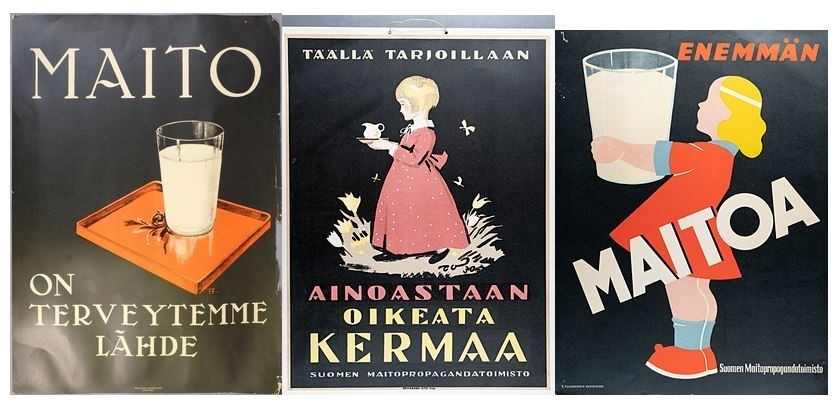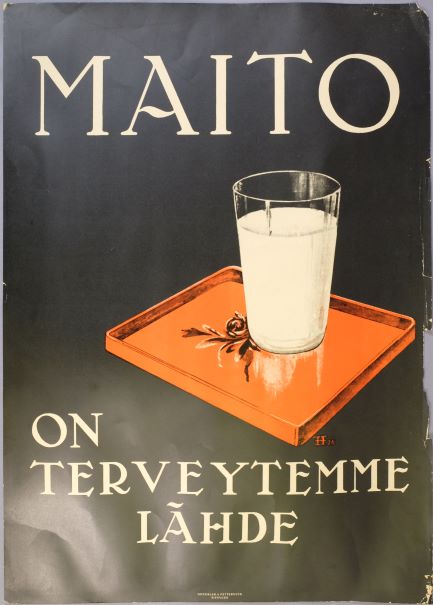A poster on the wall of the school cafeteria advocating the benefits of milk is a familiar sight for many Finns. These commonplace posters have a long history connected to both public education and support for agriculture. The collections of the Helsinki University Museum include several milk education posters. This article explores a series of 20 paper posters dating back to the 1920s and 1930s. Last winter, we participated in training entitled Merkitysanalyysia paikallismuseoille (‘Local museums analysing the value and significances of objects’) during which we analysed 20 milk posters together with the University Museum’s collections team.

Milk as a source of wellbeing
The status of milk as the cornerstone of Finnish agriculture and wellbeing has not developed out of thin air, but rather is the result of long-term branding. With the increasing mechanisation of agriculture, research on dairy farming and the quality of milk was seen as important, and public education efforts to promote animal welfare and the quality of dairy products were active. The education activities focused on both public health and production: the goal was to increase the consumption of dairy products to make citizens healthy, productive and robust.
In 1929 Kulutusmaidontuottajain liitto (a dairy producers’ association) and Helsingin Maidontarkastusyhdistys (the Helsinki milk inspection association) established Suomen maitopropagandatoimisto (the Finnish milk propaganda office), which continued the public education efforts previously made by the dairy producers’ association. The means used included milk-themed posters spreading the message to a wide audience. The milk propaganda office worked systematically to offer selected research-based information to large groups of people. The message was directed particularly at households with children. Over the decades, milk posters became an integral feature of the décor of Finnish school cafeterias.
More milk: Milk propaganda posters in the University Museum’s collections
Before we performed the analysis described in this article, little was known about the 20 posters included in the University Museum’s collections: no information on the donor accompanied the posters, and no other documents attesting to their origins had been preserved. Finding information about the posters and the people who had created them required some detective work: by consulting libraries, archives and colleagues, a clearer overview gradually emerged from the small snippets of information gleaned. The people behind most of the posters were identified and found to represent some of the best known commercial graphic designers and artists of the early 20th century.

The imagery used in the posters reflects an idyllic nationalist vision of children with blond hair and blue eyes enjoying a dairy product, such as milk. There are seven different types of motifs, of which three were also published in Swedish. In terms of style, the images vary from stylised national romanticism to more glaring illustrations typical of advertisements. The posters were printed on thin paper, and several of them have needle marks or cords.

Information and new dimension through an analysis
The approach used to analyse the posters has been developed, in particular, for the museum sector, to obtain in-depth knowledge about museum objects and collections. This research-based, collaborative and interpretative approach makes museum objects more usable and involves communities in describing the significances they ascribe to objects from their perspectives.
The milk propaganda posters were analysed by members of the Helsinki University Museum’s collections team, each from their own vantage point. We devised a questionnaire allowing the respondents to describe the feelings and thoughts the posters evoked in them. Originally, we also intended to include other University of Helsinki staff among the respondents, but this plan was scrapped due to scheduling difficulties and the coronavirus pandemic.
The responses reflected the respondents’ work and a sense of nostalgia: many linked the images to the museum collections, but also to history and their own school memories. Although some respondents had never seen the posters before, they were able to connect them to the long tradition of milk posters through their own experiences.
“[…] We were installing an exhibition in [the University’s old exhibition building] Arppeanum, and I had the opportunity to contribute to designing the exhibition room for veterinary medicine. That was when I first came across the milk propaganda posters, and two of them actually ended up in the exhibition.”
“They make me feel nostalgic, I remember seeing similar but newer ones in the cafeteria of my primary school.”
“The images clearly wish to conjure up the idea of something pure, genuine and nostalgic.”
The use of the word ‘propaganda’ in the posters also sparked thoughts:
“As a person who is familiar with delicately branded advertising, I was amused to see the name of the producer of the advertisement: after all, propaganda is something you accuse others of, not take credit for.”
“The 1930s use of the word ‘propaganda’ with no negative connotations whatsoever is also interesting.”
“Milk propaganda is also an interesting term. Propaganda is now viewed negatively, but if I understand correctly, it used to be a neutral word, a bit like communication is today.”
The respondents clearly perceived the difference in the meanings of the word in the historical context, comparing it to today. The responses also reflect current discussion:
“The images are interesting visual sources of history on milk consumption, marketing and changing ideas about health. It’s interesting to consider the role of propaganda in the abundant consumption of dairy products in our country.”
“In recent years, the dominant status of milk in the Finnish diet has provoked intense debate. People now strive to consume fewer animal products for environmental and other reasons but, in the 20th century, dairy products were seen as a simple way to improve people’s diet and its nutrition content.”
The responses reflect the historical continuum of milk education. They also reflect the relationship of museum staff to objects and to their profession: a museum professional analyses historical phenomena with the help of objects and may have a strong personal relationship to them.

A milk war or a blast from the past?
The analysis helped supplement the overview of the milk propaganda posters with both archive data and experiential views. New interpretations of familiar material add interesting dimensions to how history can be interpreted through objects in a novel and collaborative manner. For the people conducting the analysis, it was an entirely new way to perform research on objects.
The connection to current debate strengthened the idea that sometimes history repeats itself. Although more than 90 years have passed since the first milk propaganda posters were distributed, today’s marketing is governed by similar laws. In 2020 the plant-based food company Oatly distributed a leaflet on ‘milk myths’ to 200,000 families with children, questioning the environmental and health-related claims made about milk. The publication could also be read on the company’s website. The campaign gave rise to lively discussion both for and against, with some media outlets even dubbing it the ‘milk war’.
The campaign and the means used in it share some features with the milk propaganda posters: research-based information is offered to the general public, and one of the key target groups is children.
Mai Joutselainen, project employee
Marika Tarkiainen, project employee
Translation: University of Helsinki Language Services.
Sources:
Perko, Touko. Perintönä maitohygienia: Walter Ehrströmin säätiö 1958–2008. Helsinki: [Walter Ehrströmin säätiö], 2008.
Perko, Touko. Kohti EU:n parasta maitoa: Maitohygienialiiton historia. Helsinki: Maitohygienialiitto, 2011.
Hokkanen, Kari, Maidon tie. Valio ja osuusmeijerijärjestö 1905–1980, Valio, 1980
Maito-lehti nro. 3/1970
Perko, Touko, Valio ja suuri murros, Otava, 2005
Saura, E: Kulutusmaidontuottajain Liitto 1926–1926. Helsinki, 1937.
Valion aineistopankki
https://www.maitojaterveys.fi/maitoterveys-ry/historiaa.html
Maito: Kulutusmaidontuottajain liiton julkaisu
